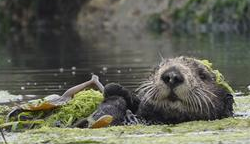Science News
Hungry Sea Otters Save Shorelines
September 24, 2013
by Jami Smith

It’s sea otter awareness week, which seems like a great time to reveal something heroic about this charismatic animal. A recent study from UC Santa Cruz concluded that sea otters are helping to save the ocean—with their appetites.
When you think of sea otters, you may think “cute and cuddly,” but these playful marine mammals are top predators, like great white sharks and tigers, and their hunt for food is helping to maintain ecosystem health along portions of California’s coastline.
The sea otter’s role in ecosystem management begins with one of its preferred foods: crabs. Sea otters eat crabs. Crabs in turn eat sea slugs and small crustaceans. The slugs and crustaceans eat algae off sea plants, keeping them green and healthy. It’s a relatively typical food web but now it’s clear: The healthier the crab-eating otter population is, the healthier the plants tend to be.
Sea plants, like eelgrass, along the west coast are important habitat for fish such as Pacific herring, halibut and salmon. They also protect shorelines from storms and waves, and they soak up carbon dioxide from seawater and the atmosphere. Thus, a healthy coastal ecosystem has the right mix of otters eating crabs and invertebrates eating algae.
Unfortunately, seagrass meadows have been declining worldwide, partly due to excessive nutrients from agricultural and urban runoff entering coastal waters. When sewage and agricultural waste like fertilizers spill into the sea, ecosystems suffer. Excessive nitrogen and phosphorus in the water spawns excessive algae growth, which can block sunlight and limit plant growth. Coastal areas that would otherwise be swaying in seagrass and kelp turn brown, murky, and barren of important marine species. But, not when sea otters are around.
Brent Hughes from the University of California, Santa Cruz and his colleagues studied 50 years’ worth of data, comparing areas with or without otters. The team discovered that otters trigger the above ecological chain reaction that protects seagrass meadows and can stave off algal blooms.
“The seagrass is really green and thriving where there are lots of sea otters, even compared to seagrass in more pristine systems without excess nutrients,” Hughes says.
Sea otters were hunted to near extinction in the 19th and 20th centuries. Populations on the California coast are slowly recovering now, and one of those places otters have called home since the 1980s is Elkhorn Slough, an estuary in Monterey Bay. Hughes and his colleagues determined that the re-colonization of that estuary by sea otters has been an important factor in the seagrass comeback.
In Tomales Bay, a nearby inlet with far lower levels of incoming nutrients, but no otters, the beds don’t look nearly as good. Hughes told Ed Yong of National Geographic:
The seagrass looks relatively unhealthy: it’s brown, covered in algae, and slumped over. The crabs are four times more abundant and 30 percent bigger than they are in Elkhorn Slough.
The findings in Elkhorn Slough suggest that expansion of the sea otter population in California and re-colonization of other estuaries will likely be good for seagrass habitat—and coastal ecosystems—throughout the state.
“This provides us with another example of how the strong interactions exerted by sea otters on their invertebrate prey can have cascading effects, leading to unexpected but profound changes at the base of the food web,” Hughes says. “It’s also a great reminder that the apex predators that have largely disappeared from so many ecosystems may play vitally important functions.”
The study was published last month in the Proceedings of the National Academy of Sciences.
(Sea otters also play a heroic role in the next Academy planetarium show! Currently in production and set for a fall 2014 opening date, the latest production from our visualization studio will highlight complex relationships in ecosystems—and how humans fit into the picture.)
Jami Smith is a science geek-wannabe and volunteers for Science Today.
Image: Robert Scoles/NOAA